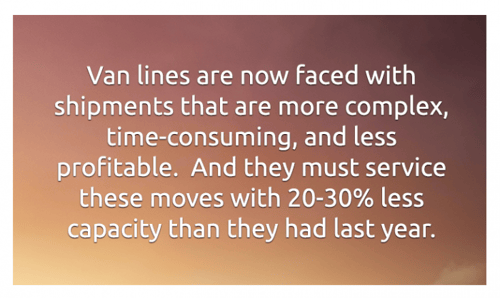May 3, 2018 This is the Year the Household Goods Industry Changes
By Ryan Keintz
You’ve heard about challenges in the household goods industry before. A driver shortage has been talked about for years. And you’ve likely heard about the tax changes and how they make HHGs moving more expensive. But there are a few other challenges occurring this year, that when combined together, will change the household goods industry forever.
 First, there is a fundamental mismatch between supply and demand. The demand has changed. While there are still moves of large homes, there has been a substantial uptick in the moves of transferees with smaller shipments. The average shipment size has reduced from approximately 12,000 lbs to 8,000 lbs in less than a decade. One of the biggest problems is the containerized infrastructure that is ideal for servicing small moves isn’t mature yet. So most movers must service the small shipments with large trucks. This not only complicates that small move but has compound effects on the mover’s overall logistics and service. With a smaller average shipment size, there are likely to be 3, 4, or 5 shipments per truck instead of one or two. That adds delays, higher costs, and increases the chance of damage as goods are moved on and off the truck multiple times in a shipment.
First, there is a fundamental mismatch between supply and demand. The demand has changed. While there are still moves of large homes, there has been a substantial uptick in the moves of transferees with smaller shipments. The average shipment size has reduced from approximately 12,000 lbs to 8,000 lbs in less than a decade. One of the biggest problems is the containerized infrastructure that is ideal for servicing small moves isn’t mature yet. So most movers must service the small shipments with large trucks. This not only complicates that small move but has compound effects on the mover’s overall logistics and service. With a smaller average shipment size, there are likely to be 3, 4, or 5 shipments per truck instead of one or two. That adds delays, higher costs, and increases the chance of damage as goods are moved on and off the truck multiple times in a shipment.
Everyone in our industry sees this challenge, but there has not been a comprehensive solution because it’s not easy to fix. Containerized infrastructure, which simplifies small shipment programs, is expensive. Even if there were several hundred million dollars of investment, the local agents must also buy in and align with new programs. It’s not one decision made by a van line, it’s hundreds.
That’s a big problem, but as of January 1st 2018, the dilemma has compounded. You may have heard that there have been some significant price increases in the moving industry this year. Why? There are a lot of reasons, but the root cause stems from Electronic Logging Devices (ELD).
ELD is essentially a GPS unit in a truck and on the driver’s phone that tracks their activity. It’s a material change that was designed to improve the safety of freight drivers. The downside is that it’s going to substantially reduce the HHG industry capacity. How much capacity will be lost? In our conversations with agents and van lines, the reduction is expected to be about 20-30%. In the past, creative logging prevented the laws from noticeably impacting the way drivers manage their moves. But ELD considers drivers working from the moment they move their truck. While drivers will find ways to optimize their processes with ELD, there are many that expect this to have huge implications for our industry.
“Everyone in our industry sees the challenges, but there has not been a comprehensive solution because it’s not easy to fix.”
Van lines are now faced with shipments that are more complex, time-consuming, and less profitable. And they must service these moves with 20-30% less capacity than they had last year. This is a recipe for disaster. With peak season starting in a few weeks, mobility managers are going to have more angry transferees asking, “How can I buy a flight in 5 minutes, fly across the country in 5 hours, and yet it’s been a month and I still don’t have my stuff?” The short-term reality is that peak season performance is likely to drop below previous year’s standards.
With HHG shipments and short-term storage becoming taxable events, moving is now also more expensive. How much more? Most companies are applying a marginal inverse gross up which increases moving spend by 13.6% to 56.8%, depending on their transferee’s taxable income. To avoid these cost increases, mobility and procurement departments will look for alternatives via RFPs for household goods, containerized shipment programs, and for the relocation management companies that manage these services.
Change happens when the pain of staying the same is greater than the pain of change.
With the substantial shifts in our industry and the pain that is likely to occur this peak season, perhaps this is the year that the Household Goods industry changes.
Find out how PricePoint can help.
Founder and President. After a career pricing for the largest international movers, Ryan observed that price manipulation was a more critical success factor than customer service or logistical expertise. He created PricePoint to fix a broken system.



